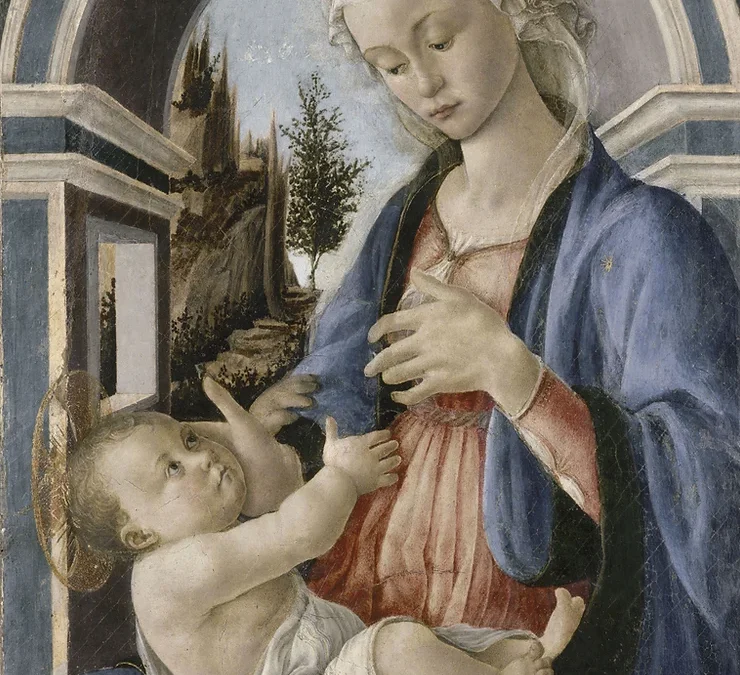MUSÉE JACQUEMART- ANDRÉ CELEBRATES FLORENTINE QUATROCENTTO ‘S FLEURS DE LIS, FLOWER-SYMBOL OF FLORENCE WITH BOTTICELLI , ARTIST & DESIGNER ‘S EXHIBITION IN PARIS
« VIRTUTEM FORMA DECORAT »
« BEAUTY ADORNS VIRTUE »
Leonardo da Vinci
A splendid exhibition in Paris at Musée Jacquemart-André gathers- until January 24 th 2022- around forty Masterpieces of Alessandro Filipepi better known as Botticelli (1450-1510) from all over the world in an hymn to the most relevant Florentine Renaissance Maestro.
An unique path to dive into Florentine Renaissance under the Reign of the Medici!
Organized by Culturespaces with the partnership of Ana de Benedetti, specialist of Renaissance Florentine Art and former Curator at Victoria & Albert Museum in London which exhibited a few years ago an important pluridisciplinary installation about Botticelli and French Pierre Curie, former Curator of Musée du Petit Palais in Avignon from where a few paintings of the exhibition actually belong, Pierre is also a specialist of Italian and Spanish Painting from XVII th century.
An example that, though the Brexit, two curators from England and France can work well together on an important exhibition project!
Often these works issued from the need to symbolize the political power and European hegemony of the Court of Lorenzo de Medici. In the bosom of this humanist cultural environment beyond the political goals of the Medici family.
The artists from Florentine Renaissance and especially Botticelli expressed the search for an Aesthetic in the hellenistic sense of the term, driven by an insatiable yearning for Beauty, Beauty which often, as in Plato, is but the harmonious metamorphosis of Good and the spiritual values that accompany it.
During Lorenzo de Medici’s reign, the flowering of the Arts elevated Florence to the rank of artistic capital of Europe if the reader can receive this anachronism about the new European concept. This position of predominance confirmed the power and influence of the Medici on the other European courts. The French Renaissance which appeared a century later, under the impulse of King François Ier, merely adopted the principle artistic currents of the Florentine Quattrocento. Within the sphere of this Florentine crucible which provided a nourishing ground for both the Arts & Sciences, man was revalorized and located as the epicenter of the creative process. Defender of the City, he was glorified for his earthly abilities.
It would be pointless to consider the proclivity of fifteenth-century art outside of the political and cultural context of the period. Man constituted the essential topos in a syncretism that mixed the ancient pagan myths of Antiquity with Christian fervor. The renewed interest for the works of Dante, Percara and Boccaccio and for the biographies of illustrious men presumes that figurative art itself represented and exalted the most well-known and exemplary historical figures. As a result, man and the cult of his image were glorified.
A century later, in 1584, Lomazza wrote: The custom of representing men goes back to a long time and the Florentine tradition from the time of Giotto makes one proud to be part of it with an expressive desire for reality.
According to Dei, the decade of 1470 belonged to a serene context in which “bread, wine and oil are abundant as peace”. The territory of Bella Firenze was vast and extended from the port of Pisa to the West where the Arno joins the Sea as far as Montepulciano to the South. The hegemony of the Medici family was based on a banking system of the highest order and a fruitful international commerce. A similar economic prosperity vitalized the explosion of the Arts. Thus, Dei describes the Florentines as beautiful, prosperous and admired by the other Italian populations. Beauty itself is the prerogative of absolute riches, but according to Leonardo’s remark “Virtutem forma decorat” , even appearance became the earthly and physical manifestation of a celestial and spiritual dimension.
The ideal of Florentine Feminine Beauty can be seen in enchanting Madonnas like the the Ruskin Madonna by Andrea del Verrochio or other ladies “full of Grace” like Sandro Botticelli’s Judith.
A canon of ideal beauty was confirmed: fine lips, straight nose, faint eyebrows, blond hair and complex hairstyles adorned with strings of pearls. Leonardo da Vinci theorized that in portraiture, figures should be “elegant and slender’ with muscles that are in proportion.
The feminine portraits of Antonio and Pietro Pollaialo like Sandro Botticelli’s Venus and Mars employ the feminine profile free from direct contact from the viewer which provide to the Ladies represented a superior, detached and hieratical dimension, isolating thus women from common mortals.
On the other hand, men assume a frontal martian position that accentuates the masculine and earthly character of Botticelli’s portrait of Giulianio of Medici for example.
The portrait in profile were undoubtedly inspired by ancient medallions.
In Florence, this type of representation symbolized virtues and moral qualities.
Botticelli, Artist & Designer’s exhibition gives an original testimony to the complexity of the Florentine Soul whose roots come from Etruscan Civilization.
The Florentine Spirit is refined, political, proud, lover of women and avid admirer of Beauty but also savvy enough to understand the spiritual transcendence that this last category imposes, to be relevant and acceptable.

Botticelli, Artiste et Designer
Until january 24th 2022 at Musée Jacquemart-André, PARIS
Organisateur: Culturespaces
Sponsor: Natixis
Le Jugement de Pâris
Botticelli & Atelier
Fondazione Giorgio Cini
Galleria di Palazzo Cini-Venezia
Copyright, Fondazione Giorgio Cini
